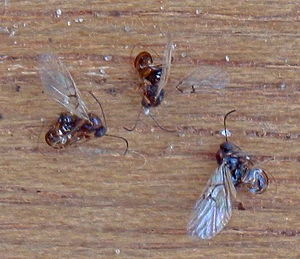
Neuroterus anthracinus
Encyclopedia
Neuroterus anthracinus is a widely distributed gall wasp
that forms chemically induced leaf gall
s on oak trees. N. anthracinus has both bisexual and agamic generations and in consequence forms two distinct galls, the oyster gall and April-bud gall.
The April-bud gall is of brief duration, the bud swelling and the insect emerging within a week from the smooth and oval 0.8 cm gall, tucked up within the bud scales. The old galls show the escape aperture clearly.

Gall wasp
Gall wasps , also called Gallflies, are a family of the order Hymenoptera and are classified with the Apocrita suborder of wasps in the superfamily Cynipoidea...
that forms chemically induced leaf gall
Gall
Galls or cecidia are outgrowths on the surface of lifeforms caused by invasion by other lifeforms, such as parasites or bacterial infection. Plant galls are abnormal outgrowths of plant tissues and can be caused by various parasites, from fungi and bacteria, to insects and mites...
s on oak trees. N. anthracinus has both bisexual and agamic generations and in consequence forms two distinct galls, the oyster gall and April-bud gall.
Synonyms
Ameristus Förster 1869, Diplobius Kinsey 1923, Dolichostrophus Ashmead 1887, Neospathogaster Kinsey 1923, Spathegaster Hartig 1840, furunculus Beyerinck 1882, ostreus Giraud 1859, ostria Hartig 1840, Andricus ostreus, Neuroterus schlechtendali and Andricus furunculus are all previous nomenclatures found in the literature.Galls
The oyster gall is found on the leaf underside, rarely above, and is around 0.3 cm across, located between the midrib and the lateral veins. It develops under the lower epidermis and when it emerges it has two flaps of valve-like tissue which remain, even after the gall has fallen. The gall has also been recorded as green, brown, pink and even with red spots.The April-bud gall is of brief duration, the bud swelling and the insect emerging within a week from the smooth and oval 0.8 cm gall, tucked up within the bud scales. The old galls show the escape aperture clearly.
Life cycle

Agamic generation
Emerging in autumn the parthenogenetic female of the agamic generation developed in the unilocular and unilarval bean-shaped structure, which is about 0.8 cm across, known as the 'oyster gall'; they lay eggs within the buds which result in the bisexual generation.Bisexual generation
The males and females emerge from the unilocular and unilarval April-bud galls in the terminal or axillary buds around May; their fertilised eggs placed in the leaf lamina result in the Oyster gall.Parasites and inquilines
Several parasites and inquilines are found in both the bisexual and agamic phases.See also
- Neuroterus quercusbaccarumNeuroterus quercusbaccarumThe common spangle gall on the underside of leaves and the currant gall on the male catkins or occasionally the leaves, develop as chemically induced distortions on pedunculate oak , or sessile oak trees, caused by the cynipid wasp Neuroterus quercusbaccarum which has both agamic and bisexual...
- Neuroterus numismalisNeuroterus numismalisNeuroterus numismalis is a gall wasp that forms chemically induced leaf galls on oak trees. It has both bisexual and agamic generations and forms two distinct galls on oak leaves, the Silk button gall and Blister gall. The galls can be very numerous with more than a thousand per...
- Neuroterus albipesNeuroterus albipesNeuroterus albipes is a gall wasp that forms chemically induced leaf galls on oak trees which has both bisexual and agamic generations and therefore forms two distinct galls, the smooth spangle gall and Schenck's gall...
- Oak marble gallOak marble gallOak marble galls develop as a chemically induced distortion of leaf buds on pedunculate oak , or sessile oak trees, caused by the parthenogenetic gall wasp which lays eggs within leaf buds using their ovipositor...
- Oak appleOak appleOak apple is the common name for a large, round, vaguely apple-like gall commonly found on many species of oak. Oak apples range in size from 2-5cm. Oak apples are caused by chemicals injected by the larva of certain kinds of gall wasp in the family Cynipidae. The adult female wasp lays single...
- Oak artichoke gallOak artichoke gallOak artichoke galls, oak hop galls, larch-cone galls or hop strobiledevelop as a chemically induced distortion of leaf axillary or terminal buds on Pedunculate Oak or Sessile Oak trees, caused by the parthenogenetic gall wasp Andricus fecundator, which lays single eggs within leaf buds using...
Sources
- Darlington, Arnold (1975) The Pocket Encyclopaedia of Plant Galls in Colour. Pub. Blandford Press. Poole. ISBN 0-7137-0748-8.
- Stubbs, F. B. Edit. (1986) Provisional Keys to British Plant Galls. Pub. Brit Plant Gall Soc. ISBN 0-9511582-0-1.

